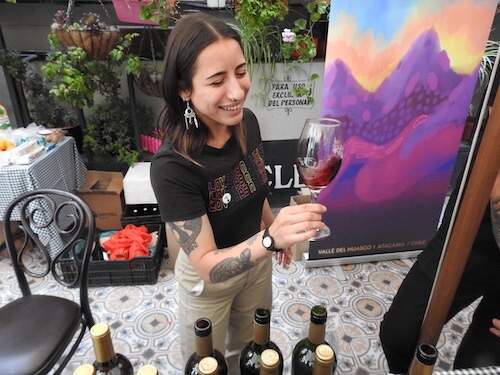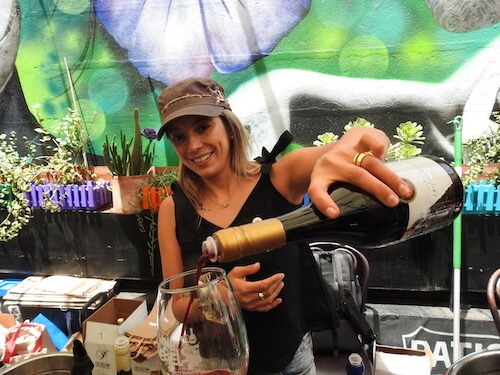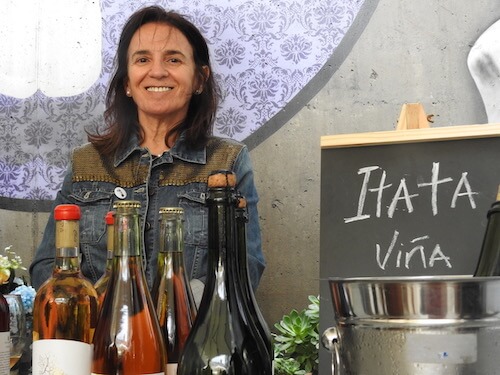 If I ask you to describe a sommelier, you’ll almost inevitably picture a man. White and middle aged, perhaps a little portly, and with a slightly intimidating air.
If I ask you to describe a sommelier, you’ll almost inevitably picture a man. White and middle aged, perhaps a little portly, and with a slightly intimidating air.
The exact opposite of Karla Abarca, who gives a huge grin as she swirls some wine around in her glass, raises it up with her tattooed arms, and takes a big, appreciative gulp. She’s a tiny powerhouse, young and lively, cheeky and irreverent, and she giggles when I tell her she looks nothing like a sommelier.
She instantly adopts a superior, masculine pose, mimicking the snobbish wine-makers of the past. Karla is the sommelier for the distribution company Wines & Co in Chile, and one of about 160 women stirring up Chile’s male-oriented world of wine-making.
Chile is a fabulous destination for wine fans, producing excellent examples of different varieties in most regions of its 4,300km length, from the deserts of Atacama to the chilly Osorno Valley in Patagonia.
Karla explains that in the arid Atacama the grapes are small but full-bodied, adding extra punch to their juice. She loves her wines, and she also loves being part of a movement that’s changing how people experience wine, making it accessible to people who ‘feel alien to this beautiful world because they ignore technicalities.’
 That was evident at the first ever ‘Ellas Hacen Vino’ event held in a restaurant courtyard in downtown Santiago. The wine was flowing steadily, and all of it was made by women who own boutique vineyards, or buy grapes to create their small-volume supplies. Fifteen producers took part, including several from the lush Itata and Colchagua Valleys.
That was evident at the first ever ‘Ellas Hacen Vino’ event held in a restaurant courtyard in downtown Santiago. The wine was flowing steadily, and all of it was made by women who own boutique vineyards, or buy grapes to create their small-volume supplies. Fifteen producers took part, including several from the lush Itata and Colchagua Valleys.
Chile’s three big wine producers dominate the retail outlets and restaurant menus, where often only 10% of the choice comes from independent suppliers. “The wine industry in Chile has some very powerful wine makers which make small producers invisible,” says sommelier Nadia Parra. Nadia organised the event through her company Wine Rebels, which runs a pop-up wine bar in a pizzeria every weekend to promote boutique vineyards. She also founded the Asociacíon Mujeres del Vino de Chile (MUV) to support, train and promote women winemakers. MUV conducts an annual survey to track their development and see how best to support them, resulting in workshops to tackle issues like how to combat sexual harassment.
Nadia describes her winemaking women as ‘mothers of the territory’ who fuel the local economy and generally specialise in small, sustainable, organic operations. “It’s a very masculine industry and I think these types of wine and women are invisible,” she says. “They make their own wines and each one has a story to tell. Some grow their own grapes, some buy grapes from other producers, and there are some tremendous women who are winning prizes.”
Chile has long been an important player in the  global wine market, ranking as the world’s fourth largest exporter in 2022. The climate dictates a leaning towards red varietals, but some beautiful Chardonnays are produced in valleys washed by cool coastal breezes. Wine tours are offered in many locations, and cycling around a stately old vineyard before sampling the produce is a wonderful way to spend a day, or a weekend. Or a week…
global wine market, ranking as the world’s fourth largest exporter in 2022. The climate dictates a leaning towards red varietals, but some beautiful Chardonnays are produced in valleys washed by cool coastal breezes. Wine tours are offered in many locations, and cycling around a stately old vineyard before sampling the produce is a wonderful way to spend a day, or a weekend. Or a week…
The industry began under Chile’s Spanish colonisers, but after gaining independence in 1818 some rich landowning families looked to France instead, and imported a wide variety of vines. It now boasts some of the oldest vines in the world, including its almost national grape, Carmenere, which was wiped out in other countries by the Phylloxera plague.
The most famous female in its wine industry was Isidora Goyenechea, once hailed as the richest woman in the world. She and her husband Luis Cousiño founded Viña Cousiño Macul, a lovely vineyard in Santiago where you can tour the grounds, the stone mansion and its impressive cellars. Isadora turned the family vineyard into an international success in the 1870s, travelling to France to select vines including Cabernet Sauvignon, Merlot and Alsace, manufacturing her own glass bottles, and pioneering Chile’s wine exports. Women have had a far lower profile since then, but MUV and Wine Rebels plan to change that.
 Javiera Ortúzar was having a great time at the tasting event, pouring samples for an appreciative audience and telling stories about her wine journey in Colchagua Valley.
Javiera Ortúzar was having a great time at the tasting event, pouring samples for an appreciative audience and telling stories about her wine journey in Colchagua Valley.
Bubbly Javiera studied oenology at the University of California, then worked on vineyards in New Zealand, Australia, South Africa, England, Germany to experience different techniques. When she returned to Chile she started buying grapes from a supplier to create her own wines.
It was more difficult to get started because of her gender, she believes. “The attitude was ‘you’re just a little girl – what do you know?’” she says. “It’s definitely become more women-friendly, but in the early days there was an attitude that you’re a woman, you know nothing, your place is in the kitchen.”
But she persevered, marketing her wines through a website and Instagram, persuading restaurants to feature them, and now exporting to Brazil through an agent.
Her wines are designed to be fresh, jovial, and easy to drink, and her progress is reflected in her labels, which feature a woman who has matured from one season to the next as the blends became more complex.
 For María Isabel Abuin, making wine is a surprise second career after years as a teacher. She took over her family vineyard in Itata Valley, the first area where vines were grown in Chile more than 400 years ago. Viña Zamora still has some centuries-old vines that were tended by her grandfather, and the terroir is rich in minerals including white quartz. Maria works by herself and her small-scale production is all carried out by hand. Before she turned commercial three years ago, the wine was filtered into 5-litre bottles and sold around the neighbourhood.
For María Isabel Abuin, making wine is a surprise second career after years as a teacher. She took over her family vineyard in Itata Valley, the first area where vines were grown in Chile more than 400 years ago. Viña Zamora still has some centuries-old vines that were tended by her grandfather, and the terroir is rich in minerals including white quartz. Maria works by herself and her small-scale production is all carried out by hand. Before she turned commercial three years ago, the wine was filtered into 5-litre bottles and sold around the neighbourhood.
She grows four types of red grapes including Pais, a traditional Chilean variety, as well as two white varieties. I sample some Chardonnay blended with Muscat, then a sweet Muscatel as smooth as syrup.
Another matriarchal business is Vina La Kura, where Clara Arteaga and her three daughters produce wines in Itata valley. The vineyards have been in her family since 1767, but the grapes were sold to other producers until Clara realised it would be more profitable and much more fun to make the wine themselves. They’re currently producing 8,000 bottles a year and want to produce 20,000, but never more than that.
The women are committed to conservation of the soil and vines by not using chemical pesticides or fungicides. Their minimal intervention policy leaves some of the Semillóns, Muscats and Cinsaults looking cloudy and dense – a rural country touch – but they taste deliciously natural. Clara says the most difficult part of the wine business is actually selling it, and a website and Instagram are her main channels to market. Plus tasting events like Ellas Hacen Vino, where the women could pour their wines, tell their stories, and win new customers.
First published by Travelhoppers.com